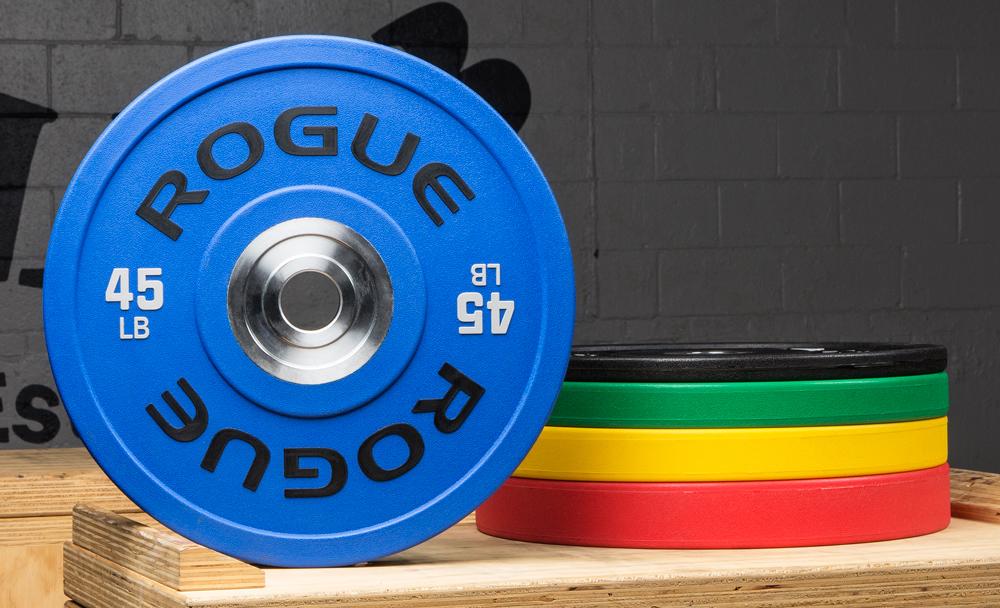REP fitness Equalizer plates vs Rogue Urethane plates
This is a comparison between the REP fitness Equalizer plates and the Rogue Urethane plates. Follow the links for more details.


Overview and review of the Rogue Urethane plates
The Rogue Urethane plates will set you back about $1150 dollars or $7.46 dollars per kg. These plates are especially good to use for gyms who want long lasting plates. This overview has originally been published in the article "Which rogue plates to buy" which you can find on this blog.
What else to consider from Rogue
Most popular Rogue plates
This is an overview of the most popular Rogue plates on Marathon-Crossfit.com in 2020 based on views and click thoughs for purchase on Rogue Fitness. If you want more detail on how the data was collected and what the strengths and shortcomings of the data set are you can dig deeper on what were the most popular rogue products in 2020.

These were the most popular rogue plates on Marathon-Crossfit.com. On the plates, I would caution between overall popularity and the popularity of my site. The plates listed below are more niche than the Rogue bumpers, the calibrated steel plates, and competition bumpers. If you want a safe bet for your use case these three might be better, as more people buy them.
-
-
-
-
-
The
Fleck plates are a variation on the Rogue bumper plates which have been infused with red, blue, yellow, and green to indicate the weight of the plates. The splash of color also makes them more fun compared to the regular bumpers. If you find the rogue bumpers too bland but also do not want to shell out more than $1000 on calibrated steel plates or competition bumpers to get color coding then the
Fleck plates are for you.
You can read the full review of the Fleck plates via this link.
The
Rogue Urethane plates are color-coded and also claim the best durability in the Rogue plate portfolio. Whether that warrants the high price tag compared to regular bumpers is a question you have to answer for yourself, but I personally don’t think so. If you want to spend more money on plates, spend it on precision rather than durability in my personal opinion within the Rogue portfolio. Rogue equipment is known to be more durable than the competition so I would not put too much focus on this unless you run an Olympic training center where the plates will go through hundreds of heavy drops per day.
You can read the full review of the Rogue Urethane plates here.
Overview of the Urethane plates
The
Rogue Urethane plates are the second most expensive ones in the Rogue portfolio per kg. What you get in return are the longest lasting, all weather plates you can obtain from Rogue. These plates are 450mm in diameter and made to IWF specs. They have a chrome insert and dead bounce on the drop. The chrome piece provides easy loading on the
bar and reduced friction on the sleeves. This is the plate to buy if your last
competition plates fell apart at the chrome insert.
Weight / Color / Diameter / Thickness / Price per pair
55LB / Red / 450mm / 58mm / $310
45LB / Blue / 450mm / 53mm / $260
35LB / Yellow / 450mm / 48mm / $220
25LB / Green / 450mm / 40mm / $160
10LB / Black / 450mm / 20mm / $70
Available sets
210lb, 2x 25-35-45LB $750
300LB, 2x 25-35-4x45LB $1050
320LB, 2x 25-35-45-55LB $1100
340LB, 2x 10-25-35-45-55 $1150
Pros of the Urethane plates
This is an all-purpose plate which will last a long time and is hard. It will take the abuse of many users of different experience levels and still look good. This is a great plate for high demands and someone who does not want to replace the plates as often compared to other plates with a chrome insert.
Cons of the Urethane plates
The biggest con is the high price. If you go for
Olympic or
bumper plates you will get a lot more kilograms per $$$. You might be buying twice in this scenario and you will also know that you took the cheap road to success. I personally stopped doing this and it yields great results.
Alternatives to the Urethane plates
C
ompetition plates will not last as long as they have a tendency to pull apart between the rubber and the chrome insert. They also bounce more. Still, if you want to get as close as possible to the real world championships, then these are the plates to go for instead with the slight risk that they might fall apart after years of heavy use.
The
black training plates are a great design from rogue which combines the
bumper plate effectiveness with the excellence of Rogue's
competition grade plates. You will find color coding and extra touches to make the plates more user-friendly and robust. This is the elegant choice of the professional.
Calibrated steel plates are the plates for anyone who wants to put the maximum amount of weight possible on the
bar while still having color-coded plates. These plates are also approved by the IPF and are used in competition. If you want to get serious about
powerlifting, this should be your choice.
Overview and review of the REP fitness Equalizer plates
This is an overview of the REP fitness Equalizer plates including pros, cons, and alternatives. The original was published under which plates to buy from rep fitness. Follow the links for more details.
Rep Equalizer iron plates $10
The
REP Equalizer plates are a great option for your home gym, if you think that simple round
iron plates are boring and too hard to pick up from the ground. These plates have a low entry price, interesting design, and can be very practical if you like them. The full specifications of these REP plates are:
Features:
-
Machine drilled center hole (not cast) for tight fit on bar.
-
Sand blasted and machined for smooth surface.
-
All surfaces rounded, no sharp edges.
-
Sandblast before painting to ensure no surface rust is painted over.
-
Powdercoated and baked for 1 hour for superior toughness and resistance to chipping.
-
Symmetrical grip holes for easy lifting off the ground, and for using individual plates in exercises.
-
Weight tolerance guaranteed within 2%
-
"X" centered in between grip holes on 45, 35, and 25, as pictured on main image.
-
255 lb set includes: (1) Pair of 45, 35, 25, 10, 2.5 lb plates. (2) Pairs of 5 lb plates.
-
275 lb set includes: (2) Pair of 45, 5 lb plates. (1) Pair of 25, 10, 2.5 lb plates.
Plate Dimensions (width/diameter)
-
2.5lb - 0.5"/6.25"
-
5lb - 0.75"/8"
-
10lb - 0.75"/9"
-
25lb - 1.5"/12.25"
-
35lb - 1.5"/14.25"
-
45lb - 1.5"/17.7"
Pros of the Rep Equalizer iron plates
-
Sleeve space
-
Holes
-
Iron sound
-
Price per kg
A big plus of
Iron plates is that they take up less sleeve space on the bar compared to
bumper plates. This makes them especially good for powerlifters as they can get more weight on the barbell than with
bumper plates. If you have limited storing space and want to max out your barbell then these plates are a good choice.
The holes in these plates mean that they are easier to move around your gym than regular
Olympic iron plates. You can also pick them up from the ground very easily. In the convenience department, these plates point big in day-to-day use.
Depending on your preferences these plates make the sound of clanging metal that some love so much. If you want to pump
iron and like the good old Ronnie Coleman days, then these are the plates for you.
Another attractive feature of these plates is that they have a decent design even though they are at the lower range of the price per kg spectrum of REP fitness.
Cons of the Rep Equalizer iron plates
One of the disadvantages of this pate is that it is
iron. This means it can corrode and also damages your floor and equipment when dropped from overhead.
Iron plates also bear a higher injury risk as the metal won't give in when it comes into contact with skin or bone. It is a lot more likely to break the skin or a bone when you collide with an I
ron plate than with a
bumper plate.
As these plates have holes in them their integrity is compromised. This means that there are a lot more opportunities for the plates to crack or catch rust than with a smooth round
bumper plate. They are also more likely to chip than a round
Olympic iron plate.
Finally, you do not have color options with these plates except grey and
black. Although these i
ron plates are easier to coat with a different color than
bumper plates if DIY is your thing.
Alternatives to the Rep Equalizer iron plates
The
REP Urethane coated equalizer plates are in my opinion the better choice as they are more forgiving on your equipment and body than the full
iron plates. If you like the idea of plates with holes in them to make them easier to carry, go for the Urethane coat instead.
If you don't care about design and convenience and all you want is the most possible amount of weight for the cheapest price that you can fit on your barbell, then go with
Olympic Iron plates. They are not as convenient as the
Urethane plates but cheaper. You also might like to go retro and just focus on lifting the weights rather than how they look in your basement.
The
Rogue 6 shooter plates follow the same idea as the
Equalizer plates. The only difference is that the holes are round rather than hexagonal. If you are leaning more towards Rogue as a brand than REP fitness to build your home gym, but like the concept of easy transport
iron plates, then the
6 Shooter is the option for you.
The Rogue Olympic Iron plates are the simplest version you can get of a plate from Rogue. Steel that fits on a barbell. Nothing more, nothing less.
If you want to be as cheap as possible then go with
TITAN and load your cart up. They also have
Iron plates in stock.
Conclusion for the Rep Equalizer iron plates
The REP Equalizer iron plates have a great design and are practical in use. If I liked them and were to buy some I would go for the
Urethane coated ones instead as they are minimally more expensive but are easier on my skin and equipment when training. They will also last longer as they are not as susceptible to rust.


